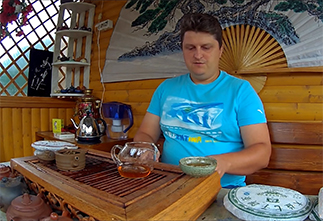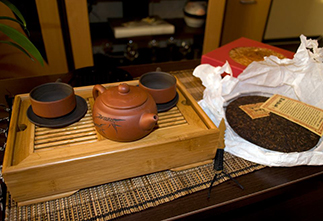Shu Pu'er 2017 "Laoshu Jingya Gongcha" brand "Kaishunhao": Treasure of old trees
Shu Puer 2017 "Laoshu Jinya Gongcha" (Chinese: 老树金芽貢茶, pinyin: lǎoshù jīnyá gòngchá) is an exceptional representative of its class, created by one of the most respected tea factories in China, "Kai Shun Hao" (Chinese: 开顺号, pinyin: Kāi shùn hào). This puer is distinguished by a deep, rich taste and multifaceted aroma, which are revealed during long-term storage.
Origin and name
- Manufacturer: Kaishunhao (开顺号) is a famous Chinese tea factory specializing in the production of high-quality pu-erhs.
- Name: Laoshu Jinya Gongcha (老树金芽貢茶) translates as "tea from the golden buds of old trees." This name reflects the origin of the raw material for this pu-erh, collected from ancient tea trees famous for their golden buds.
- Date of raw material production: 03/28/2017 – date of collection of tea leaves, which allows us to determine the age of the raw material.
- Year of pressing: 2022.
- Pressing form: Cake (bing cha) – traditional form for pu-erhs.
- Claimed weight: 357 grams.
Taste and aroma
- Appearance: It has a dark color and a dense structure.
- Aroma: Freshly broken, the pancake exudes a rich aroma of earth, wood and light fruity notes. Once brewed, the aroma develops more fully, revealing hints of dried fruit, nuts and chocolate.
- Taste: The taste of puer is deep, multifaceted, with notes of earth, wood, sweetness and slight bitterness. The aftertaste is long, pleasant, with shades of chocolate and nuts.
Beneficial properties
- Improving digestion: Shu puer helps to normalize digestion and metabolism.
- Toning the body: Tea increases vitality and vigor.
- Antioxidant properties: Protects the body's cells from the harmful effects of free radicals.
- Beneficial effects on the cardiovascular system: Helps lower cholesterol levels and improve blood circulation.
Why is it worth trying this pu-erh?
- High Quality: Produced by one of the best Chinese tea factories.
- Unique taste: Deep, rich taste with a multifaceted aroma.
- Beneficial properties: Has a beneficial effect on the body as a whole.
- Storage Potential: Shu pu-erhs only get better with age, making this tea a great investment.
How to brew
- Water temperature: 95-100°C.
- Brewing time: First rinse – 10-15 seconds, subsequent brews – 30-60 seconds.
- Amount of tea: 5-7 grams per 150 ml of water.
Shu Puer 2017 "Laoshu Jinya Gongcha" of the Kaishunhao brand is a true masterpiece of tea art. Its deep, rich taste and multifaceted aroma make it a welcome guest at a tea ceremony. This puer will be a wonderful addition to your tea collection and will give you unforgettable moments of enjoyment.
|
Name in Chinese
|
老树金芽貢茶 |
|
Pinyin
|
lǎoshù jīnyá gòngchá |
|
English name
|
Laoshu jinya guncha. |
|
Translation
|
Imperial tea from golden buds of old trees |
|
Country
|
China |
|
Provinces
|
Yunnan (云南) |
|
Manufacturer
|
Кайшуньхао (开顺号) |
|
Raw material production date
|
28.03.2017 |
|
Year of pressing
|
2022 |
|
Pressing form
|
Bing Cha (Cake Tea) |
|
Declared weight, g
|
357 |
|
Tea tree (bush) variety
|
Lao Shu |
|
Fermentation method
|
In heaps |
|
Size
|
20x20x2 |
|
Length, cm
|
20 |
|
Width, cm
|
20 |
- Комментарии
- Вконтакте
Pu-erh is one of the most unique types of tea, which only gets better with age. Many people, when they first encounter this tea, wondered: why is pu-erh more often found in pressed form (cakes, bricks, tochas), and not in loose form? The reasons for this are related to both history and the practical aspects of storing and fermenting tea. Despite modern technologies that allow the production of loose pu-erh, the shape of pressed cakes remains unchanged. And pu-erh is more often found on sale in pressed form, for example, in the form of cakes or bricks, and loose pu-erh is less common. We will talk about the reasons for pressing pu-erh into cakes in this article.
Puer is a unique Chinese tea that is distinguished by its depth of taste, complexity of aromas and versatility of aftertaste. Its taste characteristics are formed under the influence of many factors, from growing conditions to the brewing method. Let's look at the main ones.
The question often arises: how to brew puerh correctly? Sometimes the phrase "to get high" is added to it. Moreover, everyone has their own understanding of this phrase. Some mean vigor, and some - intoxication. So how to brew puerh tea correctly? Let's consider several options.
Traveling through the tea mountains, we found ourselves in another land of blue roofs - the village of Zhongcai, which is located in the Menghai district of Yunnan province. According to tradition, we were shown another local tea tree, which, according to the Chinese, is at least a million years old :) The village is very authentic, not designed for tourists, there are many wild pu-erhs there and, of course, we were warmly received. They treated us to local cuisine and tea. We also asked the residents about the prices of tea and how they have changed in recent years.
The tea ceremony occupies a special place in the centuries-old Eastern tradition. And although the essence of this phenomenon remains constant, the nature and external manifestations of the tea ceremony in different nations have their own national characteristics. In each Chinese province, the tea ceremony and the tea used in it are varied: for example, residents of the southern provinces prefer green tea, and residents of the northern provinces - red tea, in Fujian province they more often use Oolong tea, and in Yunnan province Puer tea is widely known.


























































































